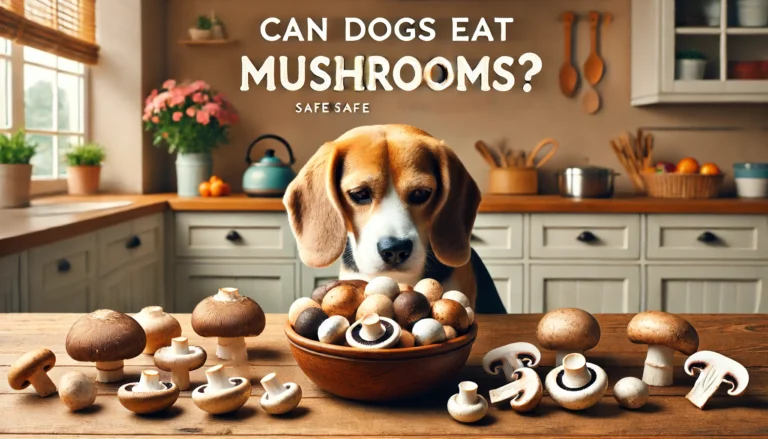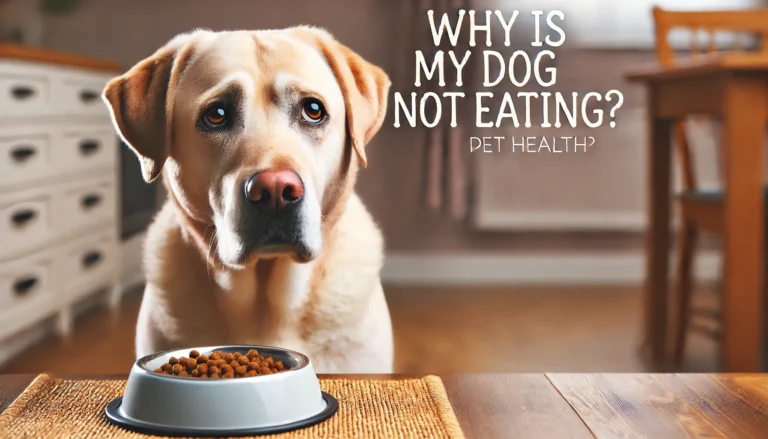What To Feed a Dog With Diarrhea?
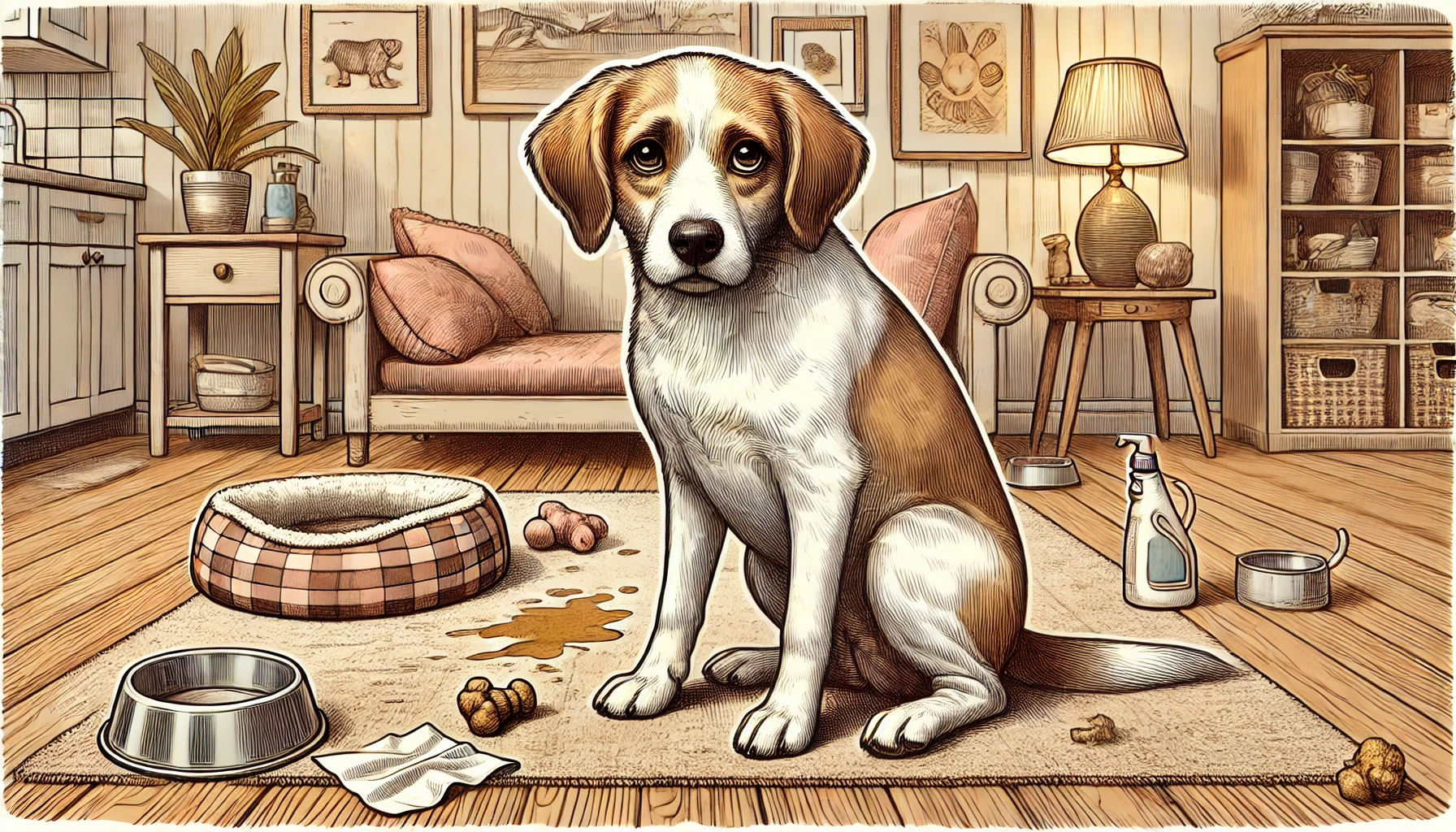
When your dog has diarrhea, feeding the right foods is essential for quick recovery. Knowing what to feed a dog with diarrhea can help soothe its stomach and prevent dehydration. A bland diet made from easily digestible ingredients works best to restore normal digestion. This article will guide you through safe food options, portion sizes, and effective home remedies to help your pet bounce back to health.
What to Feed a Dog with Diarrhea (Summary Table)
Here’s a quick reference table to help you choose the best foods to relieve your dog’s diarrhea.
| Food | Why It Works | How to Prepare |
|---|---|---|
| Boiled Chicken | Low-fat, easy to digest | Remove skin, boil, and shred |
| White Rice | Absorbs excess water in the intestines | Cook plain, without salt or spices |
| Pumpkin Puree | High in fiber, regulates bowel movements | Use canned, unsweetened pumpkin |
| Plain Yogurt | Provides probiotics to restore gut bacteria | Serve in small amounts |
| Mashed Potatoes (no butter) | Gentle on the stomach | Boil potatoes and mash without seasoning |
| Scrambled Eggs (no oil) | High in protein, easy to digest | Cook without butter or oil |
| Bone Broth | Keeps the dog hydrated and nourished | Simmer bones for hours, strain liquid |
| Cottage Cheese | Low-fat protein, easy to digest | Give in small amounts occasionally |
Bland Diet for Dogs with Diarrhea
A bland diet is the go-to solution for dogs experiencing diarrhea. It includes simple, easily digestible ingredients that reduce strain on the digestive system. These foods help firm up stools while keeping your dog nourished. Below is a common bland diet that veterinarians recommend.
Ingredients for a Bland Diet
- Boiled Chicken: Boneless, skinless chicken is low in fat and easy on the stomach.
- White Rice: Helps absorb excess water in the intestines and provides energy.
- Pumpkin Puree (optional): A fiber-rich addition that can regulate bowel movements.
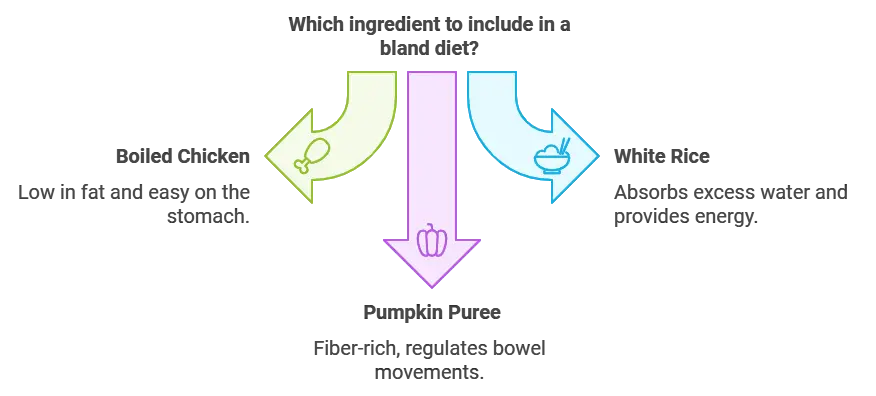
How to Prepare a Bland Diet
- Boil Chicken: Remove the skin and bones. Boil until fully cooked, then shred.
- Cook White Rice: Use plain white rice—avoid seasoning, oils, or salt.
- Combine in a 2:1 Ratio: Mix two parts rice to one part shredded chicken.
Feeding Instructions
- Start with small portions (1-2 tablespoons) every 2-3 hours.
- Monitor your dog’s stools. If they improve, gradually increase the portion size.
- Stick to the bland diet for 24-48 hours until diarrhea resolves.
- Once your dog’s stools firm up, slowly reintroduce regular dog food over the next few days.
This bland diet works because it soothes the digestive tract while giving your dog easy-to-absorb nutrients.
How Much to Feed a Dog with Diarrhea
When your dog has diarrhea, portion control is essential. Overfeeding can overwhelm the already sensitive digestive system, while small, frequent meals promote steady recovery.
Portion Guidelines Based on Dog Size
| Dog Size | Meal Size | Feeding Frequency |
|---|---|---|
| Small Dog (under 20 lbs) | 1-2 tablespoons per meal | Every 2-3 hours |
| Medium Dog (20-50 lbs) | ¼ to ½ cup per meal | Every 3-4 hours |
| Large Dog (50+ lbs) | ½ to 1 cup per meal | Every 4-5 hours |
Fasting Period (Optional)
- For mild diarrhea, a short fasting period of 12-24 hours may help the digestive system reset.
- Offer plenty of water to prevent dehydration during fasting.
When to Adjust Portions
- If stools start to firm up, gradually increase meal size and reduce feeding frequency.
- If diarrhea persists after 48 hours, keep portions small and consult a veterinarian.
Best Foods for Dogs with Diarrhea (Detailed List)
Here’s a breakdown of the safest foods you can feed your dog to soothe diarrhea and restore healthy digestion.
1. Boiled Chicken
- Why: It’s lean, easily digestible, and gentle on the stomach.
- How to Use: Boil without seasoning. Serve shredded with plain rice.
2. White Rice
- Why: Helps absorb excess water from the intestines.
- How to Use: Cook plain. Avoid brown rice, as it’s harder to digest.
3. Pumpkin Puree
- Why: High in fiber, regulates bowel movements.
- How to Use: Use canned, unsweetened pumpkin. Mix 1-2 teaspoons with your dog’s food.
4. Plain Yogurt
- Why: Contains probiotics that restore healthy gut bacteria.
- How to Use: Offer 1-2 teaspoons in moderation to avoid lactose issues.
5. Bone Broth
- Why: Keeps your dog hydrated and provides essential nutrients.
- How to Use: Simmer bones for hours, strain, and serve cooled broth.
6. Mashed Potatoes (No Butter or Cream)
- Why: Easy on the stomach and provides carbohydrates.
- How to Use: Boil, mash, and serve plain.
7. Scrambled Eggs (No Oil or Butter)
- Why: High in protein, easy to digest, and filling.
- How to Use: Lightly scramble without seasoning or oil.
8. Cottage Cheese (Low-Fat)
- Why: Contains easy-to-digest protein.
- How to Use: Offer in small amounts as part of a bland diet.
These foods will help ease diarrhea while keeping your dog nourished. Avoid adding oils, spices, or seasonings to any meals, as these can upset the stomach further.
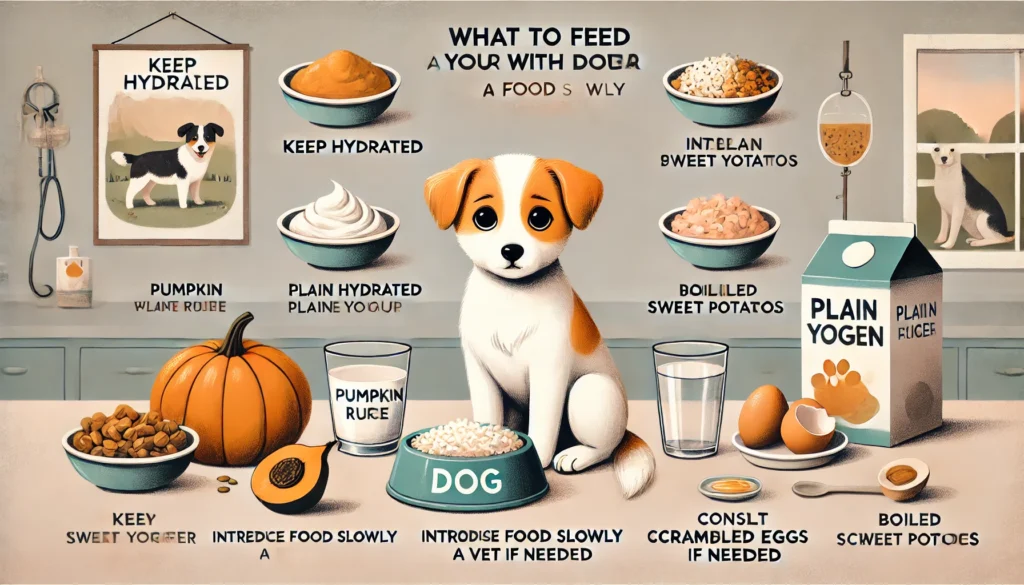
Foods to Avoid When Dogs Have Diarrhea
Feeding the wrong foods can worsen your dog’s diarrhea and slow down recovery. Here’s a list of foods to avoid and why they can upset your pet’s digestive system.
| Food | Why to Avoid |
|---|---|
| Fatty or Fried Foods | Can trigger further digestive upset and inflammation. |
| Dairy Products (except plain yogurt) | Many dogs are lactose intolerant, causing more diarrhea. |
| Spicy or Seasoned Foods | Irritates the stomach lining and worsens diarrhea. |
| Bones | Can splinter and cause intestinal blockages. |
| Raw Meat | Increases the risk of bacterial infections (like Salmonella). |
| Sugary Foods (e.g., candy) | Disrupts digestion and can lead to diarrhea or vomiting. |
| Processed Dog Treats | Contain additives and preservatives that can upset digestion. |
| High-Fiber Vegetables (e.g., broccoli) | Hard to digest, leading to bloating or loose stools. |
Why Avoid These Foods?
- Fatty, spicy, or sugary foods irritate your dog’s gut and prolong diarrhea.
- Dairy, bones, and raw meat can introduce infections or complicate digestion.
- Stick to a bland diet and reintroduce regular food only when stools return to normal.
When to See a Vet
While mild diarrhea in dogs can be managed at home, certain signs indicate that professional help is needed. Ignoring severe symptoms can lead to serious health issues, including dehydration and infections.
Red Flags to Watch For
- Diarrhea lasting more than 48 hours
- Blood in the stool (bright red or tar-like)
- Vomiting along with diarrhea
- Loss of appetite for more than 24 hours
- Lethargy or weakness
- Fever (temperature above 102.5°F / 39.2°C)
- Signs of dehydration (sunken eyes, dry gums)
When to Call a Vet
- If your dog is a puppy, senior, or has underlying health conditions
- If diarrhea occurs after eating toxic foods or foreign objects
- If your dog is showing signs of severe pain or distress
- When diarrhea is accompanied by continuous vomiting
What to Expect at the Vet
The vet may perform stool tests, blood work, or imaging (like X-rays) to determine the cause. They may prescribe medications or recommend a specific recovery diet for your dog.
If any of these symptoms appear, don’t delay contacting your vet. Prompt treatment can prevent complications and ensure a smooth recovery.
For Your Information
Following the cat vaccination schedule protects your pet from dangerous diseases. Whether it’s yearly cat vaccinations or the initial kitten immunization schedule, staying up-to-date ensures your cat’s long-term health.
Conclusion
Feeding your dog the right foods is essential for managing diarrhea and promoting recovery. A bland diet of boiled chicken and white rice, along with small, frequent meals, helps soothe your pet’s digestive system. Adding pumpkin puree or bone broth provides extra relief and hydration.
Avoid feeding your dog fatty, spicy, or processed foods during this time, as they can worsen diarrhea. If symptoms last more than 48 hours or your dog shows severe signs like vomiting or lethargy, it’s best to consult a vet immediately.
With careful dietary management and home remedies, your dog can return to normal health quickly.
FAQs
1. What should I feed my dog when they have diarrhea?
It’s best to start with a bland diet. Common options include boiled chicken (without skin and bones) and white rice, or plain canned pumpkin. These foods are easy to digest and can help firm up your dog’s stool.
2. Should I fast my dog before introducing food?
Yes, it’s often recommended to fast your dog for 12-24 hours to give their digestive system a chance to rest. Make sure they have access to plenty of fresh water during this time to prevent dehydration.
3. Are there any foods I should avoid giving my dog during diarrhea?
Yes, avoid fatty foods, dairy products, and any treats that are high in sugar or artificial ingredients. Also, stay away from high-fiber foods, which can exacerbate diarrhea.
4. How long should I feed my dog a bland diet?
You can start introducing bland foods for 2-3 days after the diarrhea subsides. Gradually reintroduce their regular diet by mixing it with the bland food over several days.
5. When should I see a vet about my dog’s diarrhea?
If diarrhea persists for more than 24-48 hours, if there are signs of dehydration, blood in the stool, or if your dog shows other concerning symptoms (like vomiting or lethargy), it’s important to consult a veterinarian.

